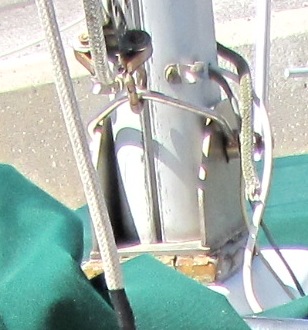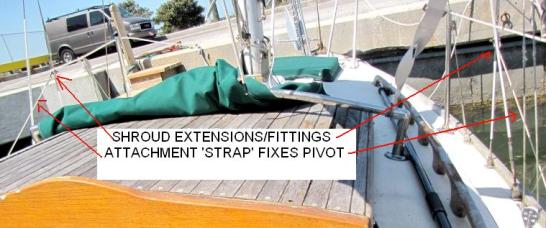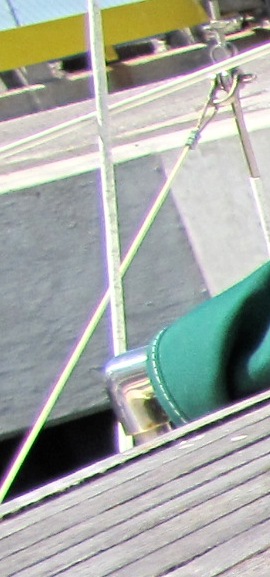I think that in order to facilitate better understanding before I attempt to describe the system for lowering of the mast I should describe the method. Raising is the reverse as described (duh). To lower the mast one clips two lines to loops at either side of the end of the boom. The other end of each is clipped to large pad eyes located both port and starboard on the deck aft of the shrouds thus securing the boom from lateral movement. The main halyard is attached to the end of the boom and tightened up. The operator then tightens the main sheet enough to put slack in the backstay and releases a push button pin form the tang at the bottom of the stay. The aft shrouds are released leaving the one shroud (each side) that is directly opposite the pivot point on the tabernacle attached. The rig is now under the control of the mainsheet and is lowered to the bow pulpit using it. When the rig is at rest the operator simply moves forward and brings the mast onboard and secures It.! One man and 10 minutes!!!!

The mast has a substantial tabernacle and the mast itself has a wooden plug inserted into its base that strengthens the bottom at the point where a 1/2" pivot bolt passes through. The front half of the mast bottom has been rounded to allow it to pivot forward and the back half of the bottom of the Mast is flat and in contact with the bottom plate of the tabernacle when the mast is upright.

 The next part of this ingenious system is to be found in the shrouds located at 90 degrees to port and starboard. A section of these two shrouds has been cut and fitted with terminal ends so that it is essentially an extension of the chain plate up to precisely the same level as the bolt in the tabernacle to which the turnbuckle is attached using a ball(?) fitting. This is the pivot point of the shroud when the mast is in motion. These are anchored through the top of the chainplate and have allowed for attachment (by shackle)of a diagonal stay lead from the top of this lower section of shroud aft to a substantial pad eye on the deck behind the aft-most chain plate. This diagonal is swaged through the pad eye. This arrangement creates a roughly equilateral triangle that resists forward pull as the mast is pivoted forward. It is these three points (with the shrouds fully tight) that are the pivot for lowering and raising the mast.
The next part of this ingenious system is to be found in the shrouds located at 90 degrees to port and starboard. A section of these two shrouds has been cut and fitted with terminal ends so that it is essentially an extension of the chain plate up to precisely the same level as the bolt in the tabernacle to which the turnbuckle is attached using a ball(?) fitting. This is the pivot point of the shroud when the mast is in motion. These are anchored through the top of the chainplate and have allowed for attachment (by shackle)of a diagonal stay lead from the top of this lower section of shroud aft to a substantial pad eye on the deck behind the aft-most chain plate. This diagonal is swaged through the pad eye. This arrangement creates a roughly equilateral triangle that resists forward pull as the mast is pivoted forward. It is these three points (with the shrouds fully tight) that are the pivot for lowering and raising the mast.
All that remains is the third part of the system. This is to provide lateral support for the mast as it arcs through its motion. This is provided by two lines with snaps at each ends that are attached to strap eyes on either side at the end of the boom with the other end secured (by stretching tight) to the after pad eye (that anchors the shroud "stay")on the deck behind the chain plates. The length and location of the pad eye allow the line to describe a perfect arc with the end of the boom
The halyard is used to support the boom to the top of the mast and the Main Sheet is used to first hold the tension of the rig while the backstay is released (there is a push pin at backstay chain plate) then as the main sheet is played out the whole rig arcs forward and down, allowing the rig to come to rest on the bow pulpit. It is then detached and carried aft for storage on board.
Fun visit, but I am really sad not to have bought her.
Fair winds
Eric
